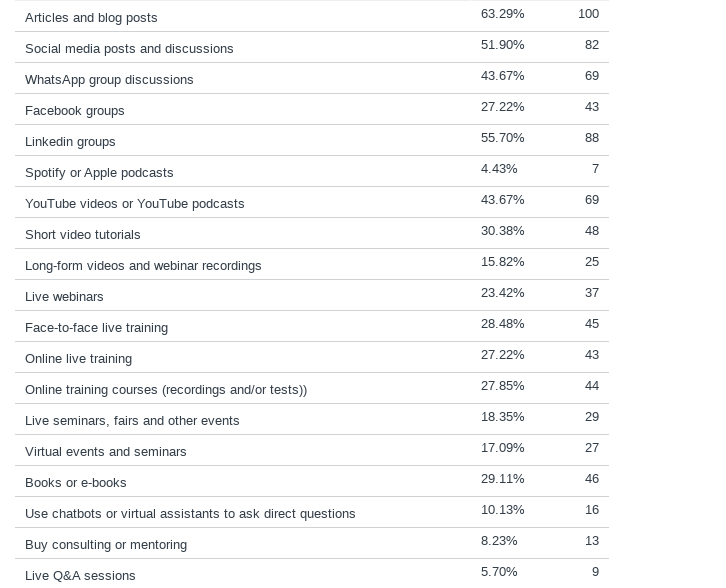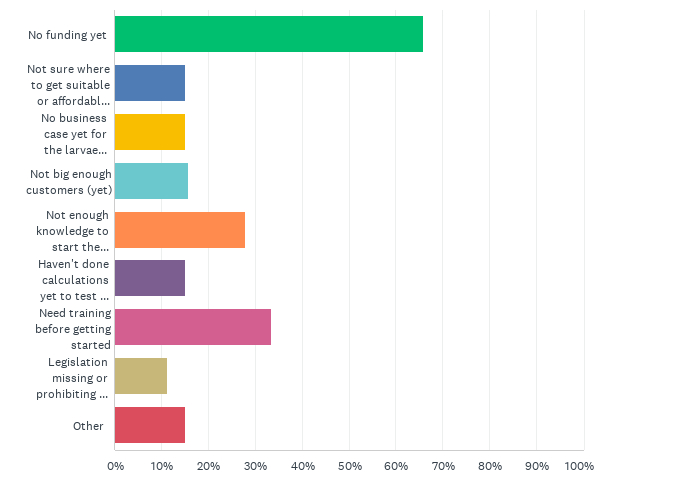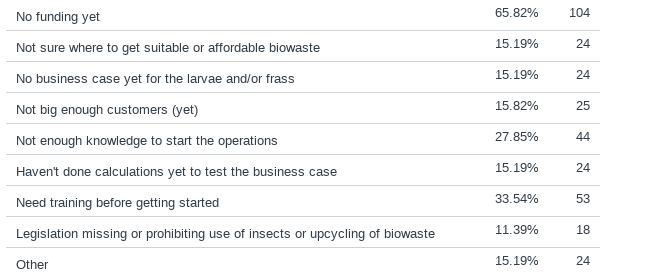
Results of the 3rd annual Insect Industry Survey, part 3 of 3
Earlier this year we launched the 3rd annual insect industry survey – again with a great number of responses, Thank You for that! This is the 3rd and final part of the results.
The production
One of our questions in the survey related to using climatization in BSF production, and the results were a little bit confusing…
Are you using climatization or other technology to manage your insect production unit?

17% of respondents said they are using some sort of climatization in their production, 43% don’t, 28% are planning to use – which sort of evens out the situation – but 24% of respondents had no idea at all what climatization is or does! A but worrying, but I guess it reflects the situation in the industry at the moment, lots of people entering the industry for the very first time, lots of interest, but still not that much information available about different production setups – or the information is seen being biased!
For those of you who are not familiar with climatization’s benefits and different production sizes and setups, at the Insect Farm Hub there’s plenty of general information and comparisons between setups available for free
We actually asked the respondents of the Insect Industry Survey if they are using the Insect Farm Hub yet, and 15% do, 74% don’t, and 19% don’t know what it is – a lot of ground to break still!
Searching for information
So, where do people generally look for information and news regarding the production of insects?

Apparently, a lot of people use Linkedin or Google, while others use Facebook (Groups, very likely), and some use Instagram, while only a handful of people use Bing as their preferred choice of information gathering. Finding information and talking to other insect farmers is a prefer method for quite a few as well, so is visiting live events around the topic, and some rely on local municipalities.
That said, Linkedin and Google seem to be the most significant places to be, but I’m afraid this may a somewhat twisted view… You see, quite a few of our survey respondents are researchers, students, or work with startups or the bigger industry players. This is likely to influence the results in a way that is not the reality among the big crowds entering this industry. The most active regions in insect farming are rural areas in South and East Africa, and South / South East Asia, and to be frank, the local chicken or fish farmers in these areas are not your typical Linkedin users.
I believe the divide is great – the researchers, startups and big company representatives are using Linkedin, while local insect farmers or insect-farming-wannabes are using Facebook groups, Instagram and rely on other farmers and local municipalities! Correct me if you think I’m totally off here, but this is my assumption based on the results and having spent years in the industry.
As a follow-up question we asked the respondents about the various means to find information, “How do you like to learn or find information about insect farming?”.
The most common response was articles and blog posts. Long-form content is far from dead and gone! The next most common means were Linkedin (Groups – quite surprisingly), and other social media posts and discussions, followed by WhatsApp groups and YouTube content.
Further down the line, and with quite significant difference, the next most popular responses were Short video tutorials, Books / eBooks, F2F live trainings, Online live trainings and Online training courses, and Facebook Groups.
And less often used means were Live webinars and Seminars, Virtual seminars, Webinar recordings, and Chatbots. Only a handful of people were interested in Podcasts (a bit surprising as podcasts are all over headlines), Live Q&A’s (very surprising!), or were eager to buy consultation, even if there is lots of consulting available!
How do you like to learn or find information about insect farming?

We also surveyed who are the most trustworthy influencers across industry, and here’s what was said (in the order of responses that came in).
Insect Farm Hub
Flying Dutchman/Alexadre Chatelier
ICIPE
Protix
Insect Farm Hub, Beta Bugs & Farm Insect
Manna Insect and ATREE
Ray Ken
Manna Insect/Toni Marjanen, Philafeed/Maya & Jason, GreenCape, Maltento, Piotrek/ ACEN, Pinnata Kanyi, FlyMumma, Christine Iriking
Manna Insect, The Protein Master (Kenya)
Muthike Jennifer
Manna Insect
Dr Hasan Fual el Taj
BioConVal Insecta
Manna insect
Plant Health – Naqia
Nari
Manna Insect, Fly Box, Better Insects Solutions, ICIPE
Dr Fahad shah
Protix, YNSECT, Nutrifarm, Divacks
Gouda
KCCA
PNG Unitech, Dr. Janet Pandi
Regenorganics
Manna Insect & Royal Entomology Society (UK)
Ykä Marjanen / Manna Insect
Congrats to all who were mentioned!
The costs and obstacles
One of the most significant costs for an insect farmer is the cost to access good quality substrate (i.e. the waste or side stream that is fed to the insect), that is of the same composition, particle size and nutritional value, and preferably doesn’t need to be mixed with other ingredients, but rather can be fed to the “maggots” as such.
Some get it for free, some have to pay and arrange picking it up, and some have to be for the substrate AND the handling costs, or the substrate may have to undergo laborious preparation or it may effect the use cases and quality of the end product. In some rare cases one gets paid to take the waste away…
That said, here’s what the respondents of the Insect Industry Survey had to say about the substrate costs:

Lucky are those that get paid to manage waste streams that can be upcycled back to life, or who can get rid of their own waste and make money or savings by doing so.
If you have biowaste stream already in place, how much biowaste do you upcycle per month (kg)?
| Production input per month | Respondents |
| 2 – 100 kg | 17 |
| 100 – 1 000 kg | 11 |
| 1 000 – 10 000 kg | 10 |
| 10 000 – 100 000 kg | 6 |
| 100 000 + kg | 1 |
Out of those who already are in production, some gave us concrete numbers of their production sizes;
| Production output per month | Respondents |
| 1 – 100 kg | 19 |
| 100 – 1 000 kg | 10 |
| 1 000 – 10 000 kg | 5 |
| 10 000 – 100 000 kg | 6 |
| 100 000 + kg | 1 |
We also asked about the price levels, and even if the stated prices vary and are in different currencies, here are definite tips for beginners on where the price levels globally are at;
1,2 USD per kg
1000 naira per kg
1kg 3500 naira
200-1000 INR per kg
300k shs for frass 50kg in Uganda
500 ET birr per kg
500 kes per kg
670000 Tsh per kg
BSF live larvae 1000 to 1500 XAF per kg
BSF Meal USD 0.5/Kg
Bsf prepupae 20 usd per kilo, frass 0,3 usd per kilo
BSF Puree from 1,500/tonne, BSF meals from 3,000/tonne (GBP) in pet sector the UK / Europe
Bsfl eggs $30-40 per gram, live bsfl $0.70, dried bsfl $1.60 per kg
BSF egg costs 20 dollars per gram
Dried larvae 250-300 pkr/kg
Dried larvae 100 kes per kg
Frass 1500 ugsh, mature larvea 2800 per kg
Frass 1500 ugsh per kilo, Animal feeds 3500 ugsh per kilo
Fresh larvae is at UGX 2500
Fresh larvae 1Kg 800Frw
The price of BSFL meal should be equal to or less than fishmeal. Currently fishmeal costs around Rs 200 per kg (~ $0.70)
Ksh 2500 per kg
Larvae is 800 naira per kg
Live larvae $1 per kg
Live larvae cost Rs 500 for 100 g, BSF eggs Rs 500 for 150 g
Live larvea kg at 1$, dried larvea at 2$
Minimum 700000 pkr per kg
One sack of frass $0,3
ZAR 80/kg live larvae
And last but not least, here’s what our respondents had to say about the biggest obstacles of getting started and/or scaling their insect operations up;


Most typically the biggest obstacle is accessing funding, a situation that doesn’t seem to be getting any easier now that USAID has stopped funding all projects in developing countries and more generally most parts of the world, and the recent bad news from some of the big players in the industry has got investors quite causes on pouring more money into insect farming. That said, there have been positive funding news also recently, but now that some of the biggest and most talked about players (namely Ynsect and ENORM) have failed, getting venture capital investments is getting really, really hard.
Some of the other typical issues in starting and scaling up are the lack of training and access to relevant information (for individual farmers), or not having a clear business case outlined yet. The training and information issue could be easily tackled with e.g. the free content at the Insect Farm Hub, numerous free webinars that many share, and talking to others, but it is of course sometimes hard to identify who are the credible experts, who want money to run trainings, etc. that may make it hard to get started.
That’s all folks, all responses to the 3rd annual Insect Industry Survey have now been passed for your perusal, best of luck in your insect farming efforts, and feel free to get in touch with us if you need support in getting the insect business up and running, you can contact us either via the Insect Farm Hub or Manna Insect website or at Linkedin, see you around!
Learn more about BSF farming in the
Insect Farm Hub!
Manna Insect has launched a comprehensive insect farming platform designed for learning, managing, monitoring and networking. There are tons of free content about insect farming, as well as a lot of paid premium content, that dives even deeper in black soldier fly business.
Read also:
Results of the Insect Industry Survey 2025 part 1
Results of the Insect Industry Survey 2025 part 2
Results of the Insect Industry Survey 2024 part 1
Results of the Insect Industry Survey 2024 part 2
Results of the Insect Industry Survey 2024 part 3
